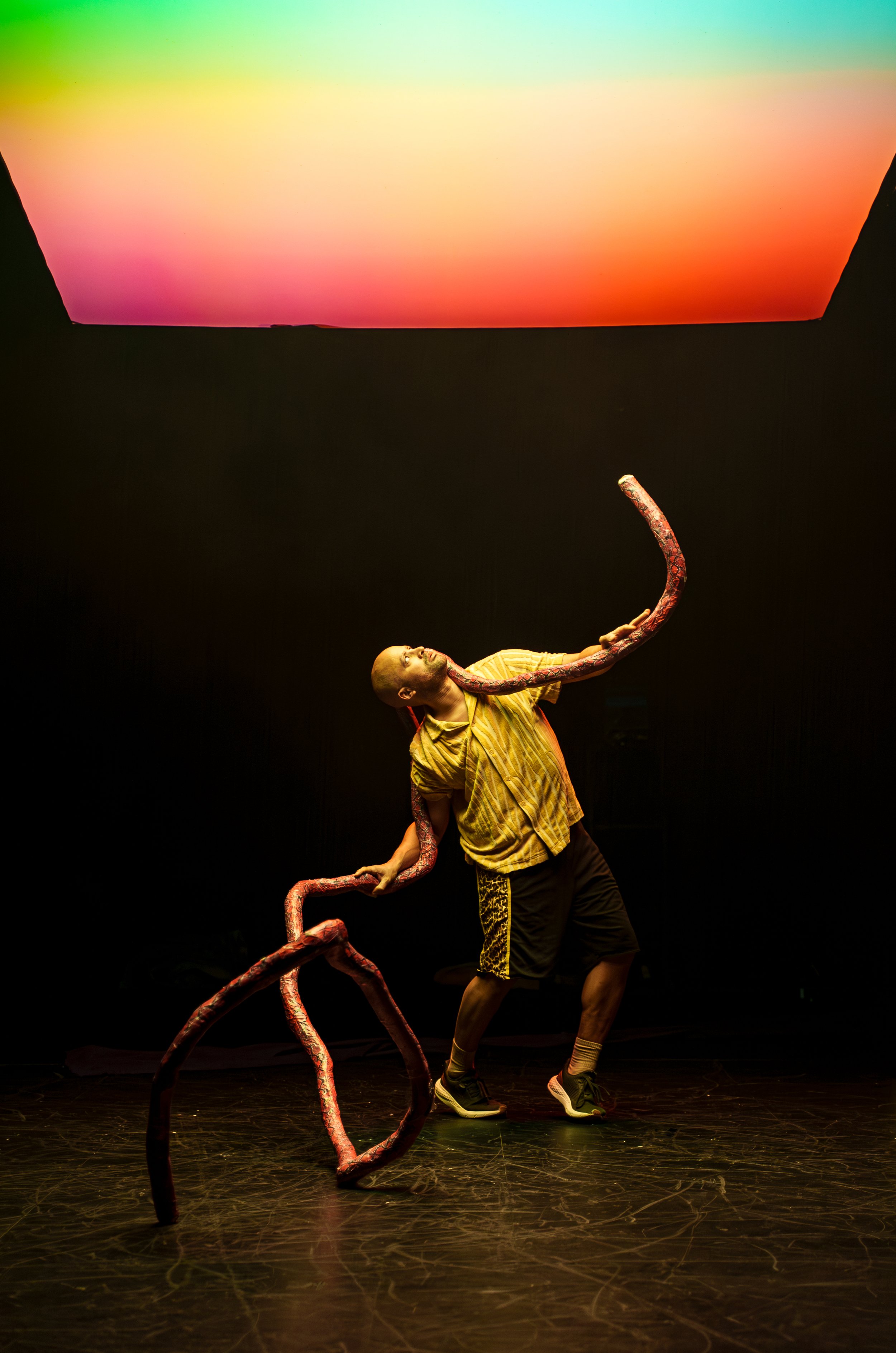Dance review: Found-object sculptures add to All That Remains' eerie landscape
PuSh Festival opener explores a dance between humans and the industrial waste they leave behind

All That Remains. Photo by Christoffer Brekne
All That Remains continues at SFU Woodward’s Goldcorp Centre for the Arts until January 24
ALL THAT REMAINS, the avant-garde dance work that opened the PuSh International Performing Arts Festival last night, originated in Denmark, but much of its imagery feels like industrial detritus washed up on a West Coast beach.
That’s in large part due to the contributions of visual artists Jaeden Walton and Taha Saraei: both recent graduates of SFU’s masters of fine arts program, they have created new iterations of the sculptures used in the show. Those set pieces are crafted from found objects, industrial waste, natural elements, and synthetic materials. Here, sadly, they’re things you see on any West Coast oceanfront, from aged Styrofoam blocks to what look like fishnets and buoys.
Choreographed by Mirko Guido, this highly experimental work starts with four dancers on the darkened stage, making eerie vocalizations and pawing at their faces—pulling their own mouths and eyes open. As their voices crescendo into a loud drone, the lights slowly rise through stage fog to reveal a sort of vast, surreal industrial wasteland.
Much of the rest of All That Remains features the dancers interacting with these distorted garbage monuments. It all makes for a haunting tableau, equal parts eco-apocalyptic and Sisyphean. One performer pulls a gigantic, crumpled blue tarp glacially across the back of the stage. Another drags a huge hunk of driftwood. And yet another pulls on a giant coiled yellow cord, stretching it across the floor.
Sometimes the figures wrestle with the garbage, or struggle under its weight. Similarly, the soundtrack builds to a percussive, electro-acoustic cacophony, strobe lights flashing. At one point in that pulsing glare, a dancer wrestles a coiled “snake” of thick plastic tubing. Later, the action turns into a sort of end-of-the-world rave, set to club beats.
Above the humans and objects, a square of light glows ominously: the threat of technology? An abstract symbol for the ever-warming sun?
Overall, the humans are complicit in the piles of garbage around them, but they also fight the junk heaps—and eventually, over the arc of the piece, assert control over them. It’s a weird, thought-provoking trip—albeit with a lot of repeated ideas and improvisational-feeling dance sequences. The work may be best appreciated as a sound and art installation, for the desolate, fog-choked space it creates and the way bodies and these found sculptures move within it. Ultimately, it’s an unsettling dance between humans and “all that remains” when they one day disappear from Earth. ![]()
Janet Smith is cofounder and editorial director of Stir. She is an award-winning arts journalist who has spent more than two decades immersed in Vancouver’s dance, screen, design, theatre, music, opera, and gallery scenes. She sits on the Vancouver Film Critics’ Circle.
Related Articles
Studies in math and an industrial fan are just some of the unexpected touches on the event’s mixed programs
Intimate duet to begin with no end explores the artists’ respective religions with care and intensity
Company 605 and T.H.E Dance Company push cross-Pacific team of dancers to embody a society rushing toward the next thing, at the Scotiabank Dance Centre
The Dust Palace’s cabaret send-up stars a visionary fashion designer who sews costumes live onstage at The Cultch
Canadian-Brazilian interdisciplinary artist brings together film and dance in a work that can be enjoyed from different angles at the Roundhouse
Marco Goecke, Crystal Pite, Sharon Eyal, and Fernando Magadan provide a whirlwind of short work for tomorrow’s next dance stars
Presented with Boca del Lupo, the accessible production by the U.K.’s Seven Circles encourages interactive learning
Aussie troupe Gravity & Other Myths’ stripped-down spectacle has been a hit around the world
Senior dance artists offer decades of insight to the new event’s joyful collaborations with younger performers
Bobbi Jene Smith and Or Schraiber share a full-evening work, and hit productions of Crystal Pite’s Frontier and Shahar Binyamini’s BOLERO X return
In the midst of an international career, the Kidd Pivot dancer is setting a short Crystal Pite work for the student showcase
Moroccan and Spanish choreographers join the international contingent of event that runs at Firehall Arts Centre and SFU Woodward’s
With the Vancouver Latin American Cultural Centre, artists Marco Esccer and Carla Alcántara celebrate the centenary of the feminist writer’s birth
Powerful dancing across the board in Medhi Walerski’s striking Last light; Bobbi Jene Smith and Or Schraiber’s straight-from-the-heart Obsidian; and Marco Goecke’s vibrating Woke Up Blind
As part of Asian Heritage Month, the gallery’s first performers-in-residence use old-school radios and headlamps in a new piece that fuses dance, multimedia, and theatre
The Dance Centre prizes carry $5,000 in funding for each artist
Fifth edition of uncurated program provides a welcoming space for artist’s first dance-theatre piece
Tickets on sale today for a Simran Sachar–Justine A. Chambers choreographic collab, comedian Kiran Deol, and Indian classical music star Alam Khan
Batsheva Dance Company alumni’s fascinating journey around the globe and onscreen finally brings them to Vancouver with Obsidian
In a surreal and outstanding conclusion to the DanceHouse season, the Belgian company warps time and gravity, toying inventively with cinematic tropes
Vancouver Playhouse performances feature choreography by Crystal Pite, Marco Goecke, Sharon Eyal, and more























